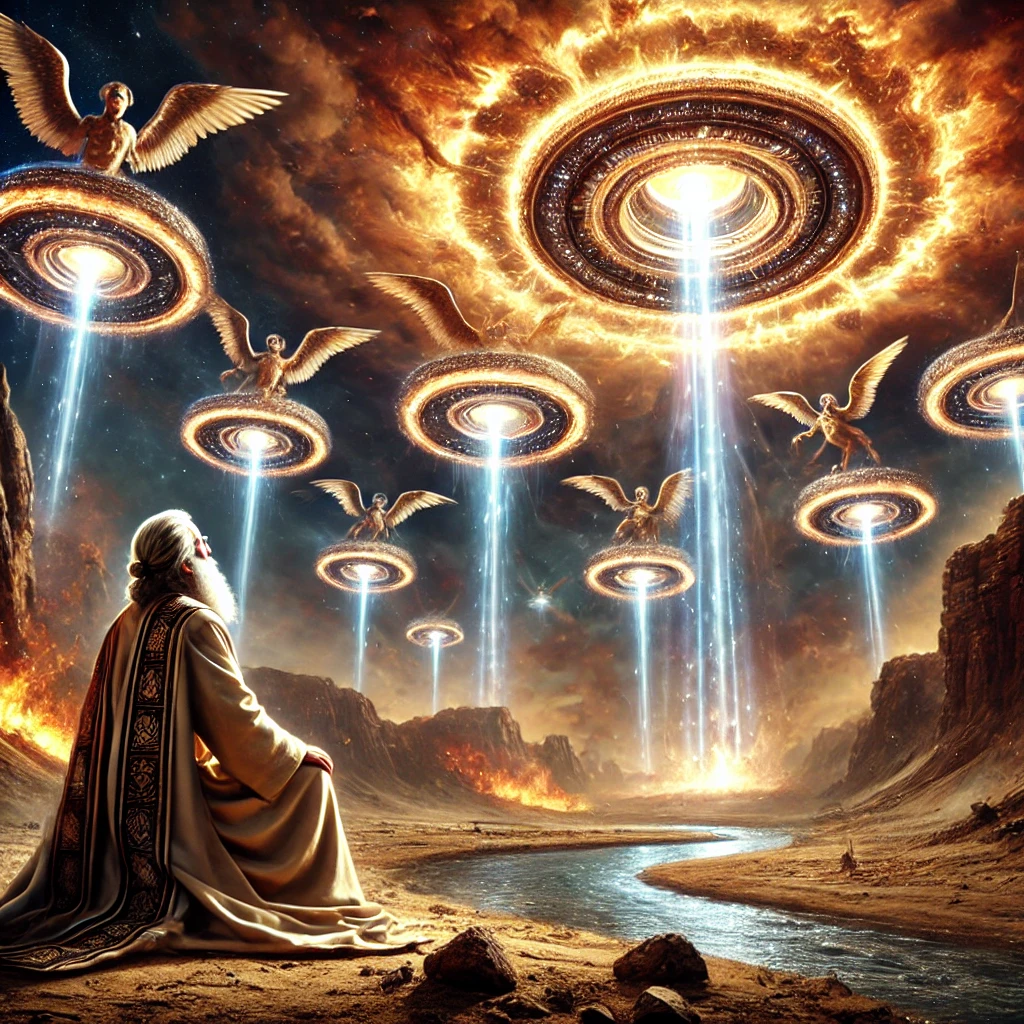Ezekiel’s Vision: Exploring Ancient Accounts of a Palace in the Sky and Celestial Encounters

Jerusalem — The biblical accounts of the prophet Ezekiel have intrigued theologians, historians, and even UFO researchers for centuries. Known for his vivid descriptions of celestial phenomena, including a “palace in the sky” and encounters with angelic beings, Ezekiel’s visions continue to spark debate about their true meaning.
Ezekiel, a prophet of the Hebrew Bible who lived in the 6th century BCE, detailed his encounters in the Book of Ezekiel, one of the most enigmatic texts of the Old Testament. His descriptions begin with a spectacular vision near the Chebar River, where he witnesses a whirlwind of fire and a mysterious structure resembling a chariot descending from the heavens.
The chariot, described as having wheels within wheels and adorned with radiant lights, was carried by four living creatures, each with four faces and wings. The creatures, identified as cherubim, moved in unison and appeared to be under the control of a divine presence. Above them, Ezekiel describes a gleaming expanse resembling crystal, with a throne-like structure and a figure “like the appearance of a man” seated upon it.
The vision, often referred to as the “Merkabah” (chariot), has been interpreted in various ways over the centuries. Traditional religious scholars view it as a symbolic representation of God’s power and majesty. Others see it as an allegory for spiritual transformation or an attempt to describe the indescribable.
In recent decades, however, Ezekiel’s visions have captured the attention of modern UFO enthusiasts and ancient astronaut theorists. Some propose that Ezekiel’s account could describe an extraterrestrial spacecraft or advanced technology, misunderstood by a prophet living in ancient times. Erich von Däniken, a proponent of the ancient astronaut theory, famously suggested in his book Chariots of the Gods that Ezekiel’s vision was a detailed observation of a space vehicle.
“The level of technical detail in Ezekiel’s description is remarkable,” said Dr. Thomas Lang, a researcher in comparative mythology. “Wheels within wheels, a glowing expanse, and beings that defy earthly explanation — it’s no wonder people draw parallels to modern UFO encounters.”
Religious scholars, however, urge caution in interpreting Ezekiel’s visions through a contemporary lens. “Ezekiel’s writing is deeply symbolic and rooted in the cultural and theological context of his time,” said Rabbi Miriam Goldstein, a biblical studies professor. “To reduce his experiences to extraterrestrial encounters risks losing the profound spiritual message of his text.”
Ezekiel’s visions were not limited to celestial chariots. He also described encounters with angelic beings and was transported in visions to what some interpret as a palace or temple in the sky. This structure, described in great detail, was seen as a representation of the divine dwelling place and an affirmation of God’s presence during the Israelites’ exile in Babylon.
Whether viewed as divine revelation, ancient myth, or evidence of extraterrestrial contact, Ezekiel’s accounts remain a source of fascination. The prophet’s vivid imagery continues to inspire religious devotion, scholarly debate, and speculative theories, reminding us of the enduring mystery of the heavens.
As humanity continues to explore space and seek answers to age-old questions, Ezekiel’s visions stand as a testament to the timeless human desire to connect with the divine — or perhaps, to understand the unknown.
Ezekiel and UFOs: A Biblical Perspective on Celestial Encounters
The Book of Ezekiel, one of the most enigmatic texts in the Hebrew Bible, has captivated readers for centuries with its vivid imagery and symbolic visions. Among these, the prophet Ezekiel’s description of a divine chariot descending from the heavens has ignited debates about its meaning. While traditionally interpreted as a depiction of divine glory, some modern theorists have suggested an alternative perspective: that Ezekiel may have been describing an encounter with unidentified flying objects (UFOs) or extraterrestrial technology.
The Vision of the “Chariot of Fire”
Ezekiel’s first vision, described in Ezekiel 1:4–28, takes place by the River Chebar in Babylon. He recounts seeing a “whirlwind” of fire surrounded by a luminous cloud. Emerging from the fire are four living creatures, each with four faces (human, lion, ox, and eagle) and wings. These beings are accompanied by wheels that intersect, described as “wheels within wheels,” which move in perfect harmony and emit an intense brightness. Above them lies a crystal-like expanse supporting a throne, upon which sits a figure resembling a man, radiating a brilliance akin to fire.
The traditional religious interpretation of this passage views it as a symbolic representation of God’s majesty and omnipotence. The cherubim and the chariot are often understood as metaphors for divine presence and guidance during the Israelites’ exile in Babylon. However, the extraordinary details in Ezekiel’s account—such as the mechanical, coordinated movements of the wheels and the dazzling luminosity—have led some to question whether the prophet was describing an encounter with advanced technology far beyond the understanding of his time.
The Ancient Astronaut Hypothesis
Proponents of the ancient astronaut theory, popularized by authors like Erich von Däniken in Chariots of the Gods, argue that Ezekiel’s vision could be evidence of extraterrestrial visitation. They suggest that Ezekiel, lacking the vocabulary or scientific understanding to describe advanced spacecraft, used the language and symbols of his time to convey what he witnessed.
Key elements of the vision, such as the “wheels within wheels” and the radiant “fire,” are often likened to descriptions of UFOs in modern times. The creatures, with their ability to move in perfect unison and their connection to the chariot, are interpreted by some as robotic or biomechanical entities, possibly part of the craft’s propulsion or guidance system.
Skeptical and Religious Perspectives
While the UFO interpretation is intriguing, it remains controversial. Critics argue that such theories impose a modern technological framework onto ancient texts that were never intended to be literal descriptions of physical events. Biblical scholars emphasize that Ezekiel’s writings are deeply symbolic, rooted in the cultural and theological context of the 6th century BCE.
Rabbi and theologian scholars suggest that Ezekiel’s vision is a form of apocalyptic literature, meant to convey spiritual truths about God’s sovereignty and presence rather than to describe physical phenomena. The “wheels within wheels,” for instance, symbolize divine omnipresence, while the cherubim represent God’s ability to act throughout creation.
Ezekiel’s Legacy in UFO Lore
Despite these objections, Ezekiel’s visions continue to be a cornerstone of UFO lore. The parallels between his descriptions and modern UFO sightings—such as luminous orbs, metallic structures, and the notion of intelligent beings descending from the sky—are hard to ignore. Furthermore, the enduring mystery of Ezekiel’s account reflects humanity’s broader fascination with the unknown and the possibility of life beyond Earth.
In recent years, interest in Ezekiel’s story has grown in light of renewed discussions about UFOs and unidentified aerial phenomena (UAPs). With governments and scientific institutions increasingly open to investigating these phenomena, Ezekiel’s visions may offer a historical lens through which to examine humanity’s long-standing relationship with the skies.
Conclusion
Whether viewed as a divine revelation, a symbolic vision, or a misunderstood encounter with extraterrestrial technology, Ezekiel’s accounts continue to inspire awe and debate. They bridge the gap between ancient spirituality and modern curiosity, reminding us of the profound mysteries that surround our existence. As humanity ventures further into space and explores the possibility of extraterrestrial life, Ezekiel’s visions serve as a timeless reminder of the human desire to understand the cosmos—and our place within it.




